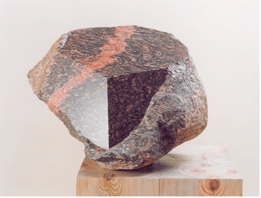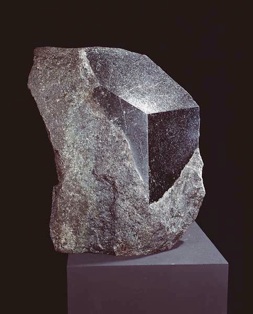Between Tradition and Novelty


One of the prominent features of modern art is its attempt at radical departure from tradition. However, quite often it is only an apparent break with aesthetic principles which raised Europe's passion in the thirties of this century. Moreover, it is a very rare case that a search for new means of expression is caused by a genuine need. Innovation is firstly linked with the necessity for permanent shock and taking a viewer by surprise, sometimes at any expense, rather than an attempt at spontaneous manifestation of one's own style and the creation of a new language of art. When in the eighties Janusz Tkaczuk finished his education at the State Academy of Fine Arts in Gdańsk, he felt less constraint on the part of the locally acknowledged artistic doctrine than the various kinds of novelties appearing in Polish and, generally, European art. One should even admit that to a certain degree he yielded to them. Some of his sculptures and actions of 1985 are proof of this. Nevertheless, the artist can be excused by the fact that it was only a beginning of his artistic path. Having learnt how "real" European artists made their works and, what's more important, having looked carefully at his own "self" - personality, Janusz Tkaczuk made his choice and returned to the roots. By this I do not mean conservative conventions but a return to the authentic experience of everyday life and the primary manifestations of creative will. The artist cares to freely manifest his own sculptural intuition. Simultaneously, his point is to avoid turning a sculpture into a mere decoration or a functional object. He believes it should be freed from the utilitarian requirements of the viewer. Sculpture should be an opportunity for the artist's personal dialogue with the world.
The beginning of Janusz Tkaczuk's creative work was closely linked with Man. His works are firstly the manifestation of his own assessment of our civilization in relation to the place of an individual in the world. It will not be a great revelation to say that the artist by moulding a man, in fact, tells us a story of himself; he derives the image of a human being from his own personality and experience. Tkaczuk's man is internally torn and tired with the fight for survival. The artist, working in plaster and cement, creates synthetic compositions free from any unnecessary details and articulating the condition of the human being. His sculptures have are a personal expression and characteristics of the model. They are executed by conventional means, nevertheless, they are bold and aggressive.

The main motif in the first period of his creation was a death mask. The artist tried to show the fragility of a human being through it and his or her struggle against fate. Human face - as Janusz Tkaczuk shows it - is the field of a hopeless fight; it "bears the taint of constant dying". His torsos represent man poisoned by civilization, his helplessness, suffering and the insignificance of any of his deeds. The artist's early sculptures are unequivocally determined in spatial relations. One can look at them from only one - front side, although they are not two-dimensional reliefs.
From 1986, the artist, like his master Franciszek Duszeńko, developed a special keen for stone. However, I believe that his choice of material was rather a question of intuition than the master's suggestion. For Janusz Tkaczuk, a simple boulder in the field is of extraordinary significance because it is a symbol of endurance and power. Stones link us to the life of the earth, they are mute witnesses of the world's history. They fascinate us with their majesty and power and incite our creative imagination.
Tkaczuk has a gift of experiencing the power of nature, its harmony, its holy order based on eternal truths embraced by the Universe's "soul". Stone "hides" a part of this soul inside itself, therefore, it is not easy to notice, feel and cognise the soul. Revealing the soul to the viewer is the greatest challenge for the artist. Being led by some archetypal impulse and trusting only his own instinct and intuition, Janusz Tkaczuk frees an artistic form from the accidental shape of a natural stone. His form retains the primary power of expression of rough material and, simultaneously, becomes a subtly modeled modern sculpture. One time, it can be an abstract composition in a dynamic shape, somehow expressing the hidden energy of the stone, not completely woken up by the blows of the artist's chisel, another time - vertical and powerful geometrical forms of wide planes, reminiscent of architectural objects. Rather rarely do we have an opportunity to see the sculptures composed of two different materials, for instance graphite and metal or granite and resin. The contrast generated by the use of different materials in one sculpture is of both symbolic and aesthetic meaning. The primary desire of the artist is to show the opposition between nature, culture and civilization. Leaving some untouched parts in a manually modeled shape, the artist plays a game with nature, he builds emotional tensions and expands a field of associations; he makes for the addition of value to the expression of stone.

For Janusz Tkaczuk, refashioning a lump of field granite into an abstract sculpture is based on retrieving its content, mass, monumentality and primordial-archaic mystery of a sign. Light plays an important role in the sounding of Tkaczuk's sculptures. The all-embracing light enhances rhythms in the division of planes and emphasizes the affinity between sculpture and a natural element, the changeability of relations between an artistic structure and natural phenomena. Beams of light reflected from the stone mass open sculptural space. They also awaken the viewer's sensitivity and attract his attention to the unity of forms. It is them that render possible a sensual grasp of associations allowing one to identify a sculptural form with dynamics, expression and the heterogeneous character of nature. The viewer can with no great effort notice that the author of the stone forms has a unique ability to feel the inside of the stone and see its soul, moreover, thanks to his sensitivity he is able to unmistakably discover regular centers of crystallization of a structural network. Tkaczuk's forms return the toil, confidence of the chisel and the spiritual world of the artist to us.
The artist believes that today, when everything becomes complicated and entangled, and what appears in modern art is mostly vanity and superficiality, it is necessary to return to the origins, simple truths, cultural endowment and nature. He rejects temporary values and chooses permanent things instead, treated in universal and even ultimate categories. He searches for primary senses of the existence of his own art, its spiritual and formal constitution. Making sculptures is for him a process which incorporates the entire emotion, aesthetic sensitivity and experience of the real world. Establishing various relations with the European heritage, at the same time, he fully enjoys freedom of expression. He chose a field stone as the experimental field of his own sculpture and as the object of his creative passion and elevated it to the position of a work of art.
Adam Pawlak